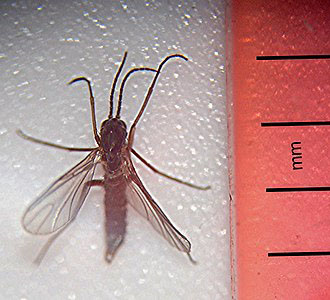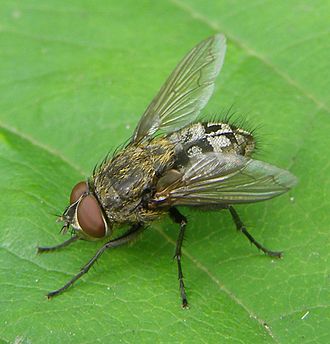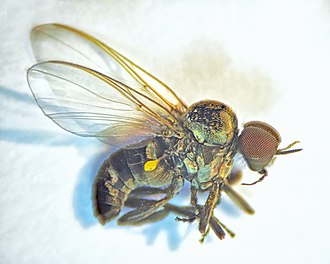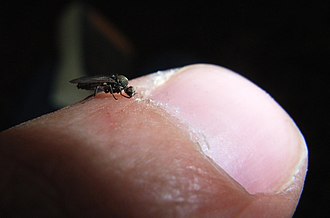Gnats and flies are annoying and frustrating, and they sure seem to be particularly bad this year. My youngest son has taken it upon himself to be the slayer of the gnats and flies, but even he has a hard time keeping up with the onslaught of flying buggers. In addition to his standard plastic flyswatter, he’s also equipped with the Zap It Bug Zapper.
It’s true that gnats are a seasonal pest, and they won’t last forever, but they still seem to swarm into the kitchen from the backyard whenever the sliding glass door is open. They particularly love my potted plants, and they flock toward the bananas and other ripening fruit. So, how do we protect ourselves from gnats and flies? And how can I keep them from swarming me when I’m out in the yard AND in my kitchen? Here are a few tips that seem to help!
What Are These Little Monsters?
First of all, what types of bugs are attacking me? I call them gnats and flies, but there are a bunch of different varieties of flying pests that could be affecting you in your home. While we could go into all the technicalities and scientific names, gnats are still really small flies. So, you might know them by a few different names. Still, there are a few types that are generally more common. They may be small — most of them are smaller than ⅛ inch — but they sure can drive you to madness with their constant buzzing and swarming.
Fungus Gnats or Winter Gnats

Habitat: These gnats are most common in areas of high humidity. They might hang out in your houseplants, particularly if they are overwatered or have standing water in the pot.
Beyond the annoyance factor, they also feed on plant roots, which can adversely affect the health of your houseplants.
Eye Gnats, Grass Flies, Cluster Flies, or Eye Flies

Habitat: Eye gnats/flies may live in loose, sandy soil, but they can be found in a variety of other environments as well.
These little gnats/flies are particularly annoying because they are attracted to the fluids from your ears, eyes, and nose. Beyond the annoyance factor, they can spread pink eye, skin infections, and rabies.
Buffalo Gnats or Black Flies

Habitat: You’ll usually find buffalo gnats or black flies if you live near a stream or lake, but they can also fly distances of up to 10 miles.
The buffalo gnat or black fly bites to draw blood. Beyond the pain associated with the bite, you could also have an allergic reaction, which could lead to itching and swelling. In some cases, they can also transmit the parasitic nematode responsible for river blindness.
Sand Gnats, Sand Flies, Sandflea, Biting Midges, Chitra, Granny Nipper, No-See-Um, or Punky

Habitat: You’ll usually experience these no-see-ums at dusk or dawn. You might find them in wet soil or sand, including beach areas, swamps, lagoons, wet and soggy fields, marshlands, etc.
No-see-ums are attracted to darker colors but also shiny surfaces, warmth, and moving objects. They travel in swarms, and when they bite, their anticoagulant residue can cause a red and bumpy rash, or they can transmit disease. They are attracted to moisture, organic matter, and sweet smells.
What Attracts Flies And Gnats To My House?
As we’ve already established by looking at some of the most common flies and gnats, they love soil, which is why they like to hang out around my houseplants. They also love the fruit bowl on the counter and the kitchen sink. Depending on the type of gnat or fly, they might lay their eggs in your garbage disposal, drain, and sponges, as well as just about any other area that’s dark and damp.
So, you no longer have to wonder why you suddenly have a horde of annoying pests after just a few days. It quickly becomes more of an annoyance the longer you let the problem persist. Ultimately, the real question is…
How Do You Get Rid Of Gnats And Flies?
As you’ve probably already discovered, it’s a lot easier to attract those flies and gnats than it is to remove them from your home. They could have been attracted by the fruit on your counter when they entered through that open back door, but they can hide in the most obtuse areas of your house and kitchen, which can be maddening.
Here are a few fixes we’ve tried.
Cats
I have to say that cats are really great flycatchers. We always had a few cats romping around the house when I was growing up, and they always took care of flies as well as gnats and other pests. Unfortunately, we’ve got cat allergies in my house now, which prevents us from keeping a cat as part of the family. So, we’ve got to find other solutions to get rid of our flies and gnats.
Weekend highlights: finally getting to see Ruby Turner live 👍❤️ and watching this wee cat chase gnats in the garden sunshine 😎👍❤️🐈 pic.twitter.com/xbCB6c6UmL
— Mark Shephard 🏳️🌈 (@shephard_mark) June 23, 2019
The Vinegar Fix
For fruit flies, take a mason jar, put a couple of inches of apple cider vinegar in it along with two drops of dish soap. Swirl the liquid concoction, cover it with plastic wrap, and poke a couple of holes in it. This fix works like a charm and there are a few vinegar concoction variations.
A Glass Of Wine
It might not seem like a great trap, but have you noticed how many times a gnat or fly lands in your glass of wine when you’re just sitting down to relax and enjoy your evening? Gnats and even flies are attracted to the sweet aroma of fermented fruit (aka wine), and a glass or cup filled with stale red wine is particularly effective as a trap.
Get rid of gnats using red wine. #gnats #pests #hooray pic.twitter.com/R8B21CaPoO
— #Mrs.Tori (@vickyintx) April 21, 2013
The Fruit Trap
Speaking of sweet smells, fruit flies are attracted to a fruit trap. It’s the same general idea as the glass of wine. You just cut up bananas, oranges, and/or other ripe, sweet-smelling fruit and put it in a container. Cover the container with plastic wrap and poke holes in the top to prevent escape. You’ll need to repeat the process as needed to prevent the smell of overly ripe fruit from becoming an issue. You could also try orange peel extracts and citrus juice as part of your trap.
Diluted Bleach
If you’ve noticed that gnats are flying out of your drains or sink, you can try pouring diluted bleach into the sink and drain to get rid of the gnats. Gnats love the moist, dark areas, but they may also be attracted to the organic material in your garbage disposal. Be sure to regularly keep that cleared out to avoid future issues.
Soil Fix
Now that you know that gnats are likely attracted to your over-watered soil, you should focus on fixing the problem. It could be that your soil is old or that you already have an issue with fungus in your pots, which is another common reason that the gnats could be attracted to your houseplants. You can buy healthy soil with good texture, a healthy pH, and organic matter, or you could create and improve your soil.
View this post on Instagram
Compost Heap Misdirection
This might be the perfect opportunity to start a compost heap outside, which is located well away from the house. It’s a good way to recycle your organic materials without attracting unwanted pests to your kitchen. Your compost can also be a great way to produce rich soil for use throughout your yard.
The Candle Fix
The candle-and-water fix is another one that sounds counterintuitive, but it makes sense, if you think about it for a minute. This fix involves taking a candle that’s in a tin or candlestick and placing it in a bowl or larger container of water. Those infamously annoying flying pests are often attracted to flame, bright lights, etc. So, when you turn off the lights, they are attracted to the flame for their kamikaze mission, or they fall into the water. You can add a few drops of dish soap to the water as well for added effectiveness.
By now, you’ve probably realized that there are lots of ways to get rid of flies and gnats. If you’ve tried these methods, you may find some are more effective than others. While I avoid insect repellents, insecticides, and sprays, as a safety measure, those might be great options for you and your family. And, of course, sticky fly traps are also a great option.
How To Prevent Gnats & Flies From Bugging You
I firmly believe that prevention is a much better way of attacking the problem, whenever possible. So, as much as I love to see how diligent my son is with his fly adventures, here are a few tips for avoiding the problem of gnats and flies in my house.
Keep Doors Closed
It’s not always easy to keep the door closed, particularly when we’re going in and out to play or check on the grill. But an open door really is an open invitation to flies, gnats, and other flying pests to come in the house and annoy us all. Along the same lines, though, you should fix those cracks and tiny holes around your doors, and repair any tears in your screens.
Be Aware Of Lighting
It’s easy to forget how attractive your lighting is to those flies and gnats, so be aware and turn your lights off when they’re not needed. When you’re more cautious about your use of electricity and lighting, you’re also likely to be more energy-efficient, which may just save you money as well.
Cleanliness Is Key
We keep the sink clear and the dishwasher closed. We also take care of the trash and recycling, so they won’t become temptations for the peskiest of flies and gnats. It may seem like little things, but just taking simple precautions in those areas can make your kitchen an unwelcome space for gnats and flies.
Wash Fruit and Veggies
You may have noticed that fruit and veggies sometimes have that sticky residue on them when you get them from the store. The microscopic fungus may have also hitched a ride, which is also a tasty treat for gnats. It doesn’t take more than a few minutes to wash your fruit and veggies when you first bring them in the house, but it can make a big difference in pest control.
View this post on Instagram
As for me, I still like using eucalyptus and lavender as a spray and in the diffuser to repel pests and also to help with any of those annoying side effects from bites. Flies and gnats are always there somewhere. Now, you too have a whole arsenal of solutions that will get you through the next onslaught.

How do you deal with gnats and flies? Let us know if you have any DIY methods that work for you in the comments below!
For More Home Help, Check These Out:

